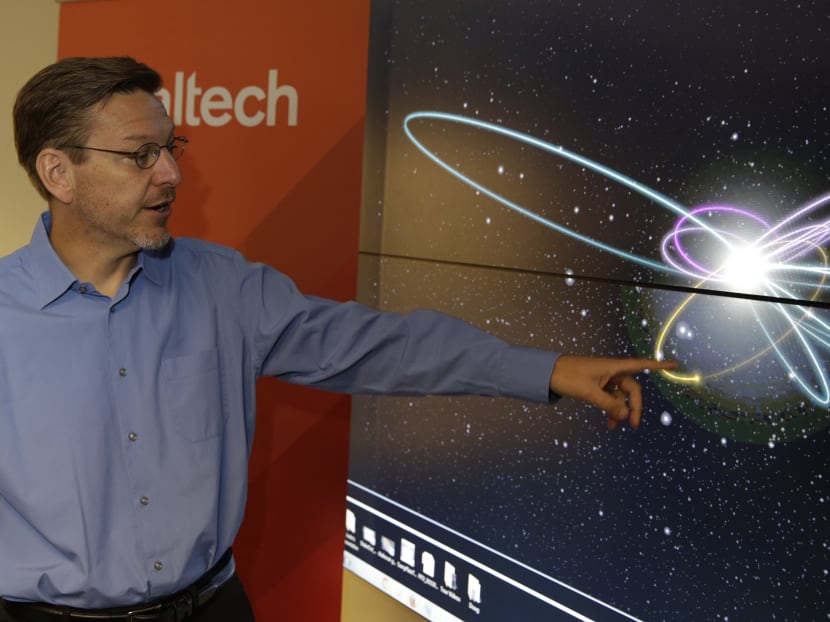Scientists think a 9th planet exists; but have yet to find it
NEW YORK — There might be a ninth planet in the solar system after all, and it is not Pluto.

Caltech astronomer Michael Brown points to a yellow dot simulating Planet 9 on a computer video simulation. Photo: AP
NEW YORK — There might be a ninth planet in the solar system after all, and it is not Pluto.
Two astronomers reported yesterday (Jan 21) that they had compelling signs of something bigger and farther away — something that would satisfy the current definition of a planet, where Pluto falls short.
“We are pretty sure there’s one out there,” said Dr Michael E Brown, a professor of planetary astronomy at the California Institute of Technology.
What Dr Brown and a fellow Caltech professor, Dr Konstantin Batygin, have not done is actually find that planet, so it would be premature to start revising mnemonics of the planets.
In a paper published in The Astronomical Journal, Dr Brown and Dr Batygin laid out a detailed circumstantial argument for the planet’s existence in what astronomers have observed: A half-dozen small bodies in distant elliptical orbits. What is striking, the scientists said, is that the orbits of all six loop outwards in the same quadrant of the solar system and are tilted at about the same angle. The odds of that happening by chance are about 1 in 14,000, said Dr Batygin.
A ninth planet could be gravitationally herding them into these orbits.
For the calculations to work, the planet would be at least an equal to Earth, and most likely much bigger — perhaps a mini-Neptune, with a small but thick atmosphere surrounding a rocky core and mass about 10 times that of Earth.
Pluto, at its most distant, is 7.4 billion kilometres from the sun. The potential ninth planet, at its closest, would be about 32 billion kilometres away; at its farthest, it could be 161 billion kilometres away. One trip around the sun would take 10,000 to 20,000 years. “We have pretty good constraints on its orbit,” said Dr Brown. “What we don’t know is where it is in its orbit, which is too bad.”
This would be the second time that Dr Brown has upended the map of the solar system. In January 2005, he discovered a Pluto-sized object, now known as Eris, in the Kuiper belt, the ring of icy debris beyond Neptune. The next year, the International Astronomical Union placed Pluto in a new category, “dwarf planet”, because in its view, a full-fledged planet must be the gravitational bully of its orbit, and Pluto was not.
The first indication of a hidden planet beyond Pluto had come a couple of years earlier. The Kuiper belt
extends outward from Neptune’s orbit, about 4.5 billion kilometres from the sun, to a bit less than twice Neptune’s orbit, about 8 billion kilometres. Dr Brown and two colleagues spotted a 965km-wide icy world at a distance of 12 billion kilometres that remained well outside the Kuiper belt. No one could convincingly explain how the object, which Dr Brown named Sedna, got there, and the hope was that the discovery of more Sedna-like worlds would provide enlightening clues.
Finally, in 2014, Dr Chadwick Trujillo, who had worked with Dr Brown on the Sedna discovery, and Dr Scott S Sheppard, an astronomer at the Carnegie Institution for Science in Washington, reported a smaller object in a Sedna-like orbit, always remaining beyond the Kuiper belt.
Dr Trujillo and Dr Sheppard noted that several Kuiper belt objects had similar orbital characteristics, and they laid out the possibility of a planet disturbing the orbits of these objects.
Dr Alessandro Morbidelli of the Cote d’Azur Observatory in France said he was convinced.
Dr Morbidelli said a possible ninth planet could be the core of a gas giant that started forming during the infancy of the solar system; a close pass to Jupiter could have ejected it. Back then, the sun resided in a dense cluster of stars, and the gravitational jostling could have prevented the planet from escaping to interstellar space. “I think they’re on to something real,” he said. THE NEW YORK TIMES





